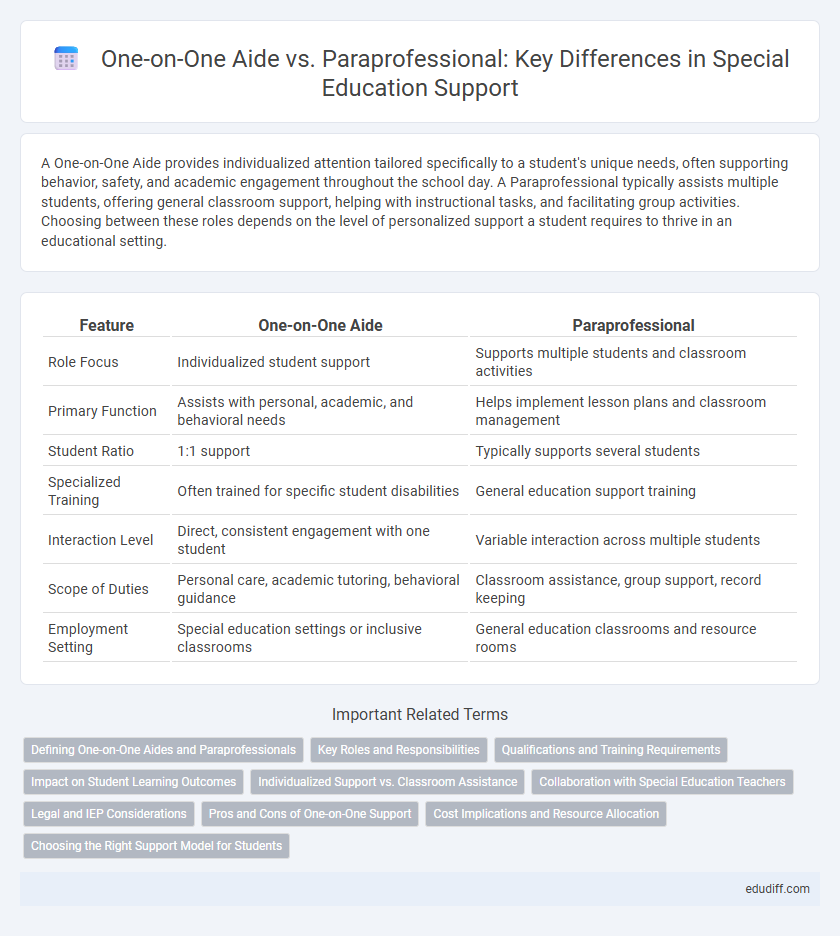A One-on-One Aide provides individualized attention tailored specifically to a student's unique needs, often supporting behavior, safety, and academic engagement throughout the school day. A Paraprofessional typically assists multiple students, offering general classroom support, helping with instructional tasks, and facilitating group activities. Choosing between these roles depends on the level of personalized support a student requires to thrive in an educational setting.
Table of Comparison
| Feature | One-on-One Aide | Paraprofessional |
|---|---|---|
| Role Focus | Individualized student support | Supports multiple students and classroom activities |
| Primary Function | Assists with personal, academic, and behavioral needs | Helps implement lesson plans and classroom management |
| Student Ratio | 1:1 support | Typically supports several students |
| Specialized Training | Often trained for specific student disabilities | General education support training |
| Interaction Level | Direct, consistent engagement with one student | Variable interaction across multiple students |
| Scope of Duties | Personal care, academic tutoring, behavioral guidance | Classroom assistance, group support, record keeping |
| Employment Setting | Special education settings or inclusive classrooms | General education classrooms and resource rooms |
Defining One-on-One Aides and Paraprofessionals
One-on-one aides provide individualized support to students with disabilities, focusing on personal care, classroom assistance, and behavior management tailored to the student's unique needs. Paraprofessionals support teachers by assisting with instructional activities, managing classroom resources, and facilitating small group learning, without being assigned to a single student. The primary distinction lies in the one-on-one aide's direct, individualized attention versus the paraprofessional's broader instructional support role within the classroom.
Key Roles and Responsibilities
One-on-One Aides provide personalized support to individual students with disabilities, assisting with daily activities, communication, and behavior management to ensure inclusion and accessibility in the classroom. Paraprofessionals support teachers by reinforcing instructional activities, managing classroom behavior, and preparing materials, often assisting multiple students in group settings. Both roles are critical in special education, with One-on-One Aides focusing on individualized attention while paraprofessionals contribute to broader classroom management and instructional support.
Qualifications and Training Requirements
One-on-One aides typically require a high school diploma or equivalent with on-the-job training focused on individual student needs, while paraprofessionals often need formal certification or an associate degree alongside specialized training in instructional strategies. Paraprofessionals are trained to support classroom instruction and manage a broader range of educational tasks, emphasizing both academic and behavioral assistance. Aides usually receive customized training tailored to the specific student they support, reflecting a more personalized approach compared to the standardized requirements for paraprofessionals.
Impact on Student Learning Outcomes
One-on-One Aides provide individualized support tailored to a specific student's needs, often resulting in improved academic performance and social skills by offering targeted interventions and continuous assistance. Paraprofessionals, while supporting multiple students, contribute to a collaborative learning environment that fosters inclusion and peer interaction, which enhances engagement and overall classroom dynamics. Research indicates that the effectiveness of both roles depends on training quality, implementation fidelity, and alignment with individualized education program (IEP) goals, directly impacting student learning outcomes.
Individualized Support vs. Classroom Assistance
A One-on-One Aide provides individualized support tailored to a student's unique needs, ensuring personalized attention and direct assistance with learning and behavior. In contrast, a Paraprofessional offers classroom assistance by helping manage group activities, supporting the teacher, and facilitating a conducive learning environment. Both roles are essential but differ in focus, with aides concentrating on one student and paraprofessionals supporting multiple students within the classroom setting.
Collaboration with Special Education Teachers
One-on-one aides and paraprofessionals both play vital roles in supporting students with special needs, but their collaboration with special education teachers varies. One-on-one aides typically work closely under the direct supervision of special education teachers, providing individualized assistance tailored to the student's specific goals and needs. Paraprofessionals often support multiple students and classrooms, requiring coordinated communication with special education teachers to implement instructional strategies and behavioral interventions effectively.
Legal and IEP Considerations
Legal frameworks under the Individuals with Disabilities Education Act (IDEA) mandate specific roles and responsibilities for one-on-one aides and paraprofessionals in Individualized Education Program (IEP) implementation. One-on-one aides are typically assigned exclusively to one student and provide direct support, while paraprofessionals often assist multiple students under teacher supervision, emphasizing the need for clear delineation in IEPs to ensure compliance and appropriate service delivery. Accurate documentation and adherence to legal guidelines are critical to safeguarding student rights and maintaining the integrity of IEP provisions.
Pros and Cons of One-on-One Support
One-on-one aides provide personalized attention, enhancing student engagement and addressing individual needs effectively. However, reliance on a single aide can limit social interaction and may foster dependency, hindering independent skill development. Unlike paraprofessionals who support multiple students, one-on-one aides offer tailored assistance but require higher resource allocation and intensive monitoring to ensure balanced progress.
Cost Implications and Resource Allocation
One-on-one aides typically incur higher labor costs compared to paraprofessionals due to their dedicated, individualized support, which demands more intensive resource allocation per student. Paraprofessionals offer more flexible support across multiple students or classrooms, optimizing staff utilization and reducing overall expenses. Efficient budgeting must consider the balance between personalized care benefits provided by one-on-one aides and the broader cost-effectiveness of paraprofessionals to maximize educational outcomes within funding constraints.
Choosing the Right Support Model for Students
One-on-One Aides provide individualized attention and direct support tailored to students with specific needs, ensuring focused assistance throughout the school day. Paraprofessionals offer flexible, multifaceted support across diverse classroom settings, facilitating group instruction and behavioral management. Selecting the ideal support model requires assessing the student's unique learning requirements, communication abilities, and social interactions to optimize educational outcomes effectively.
One-on-One Aide vs Paraprofessional Infographic

 edudiff.com
edudiff.com